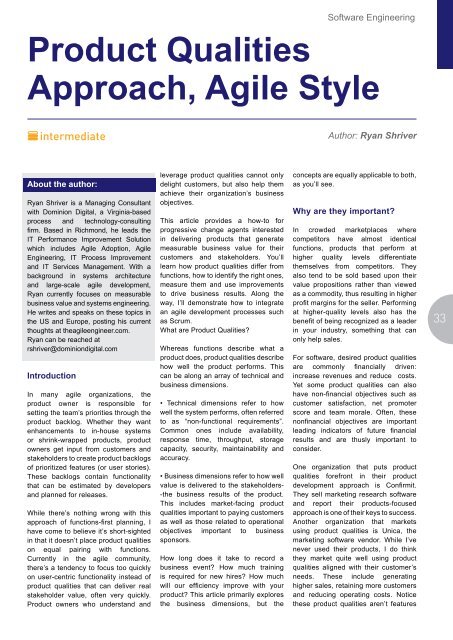Comparison of Change Management Systems
Comparison of Change Management Systems
Comparison of Change Management Systems
Create successful ePaper yourself
Turn your PDF publications into a flip-book with our unique Google optimized e-Paper software.
S<strong>of</strong>tware Engineering<br />
Product Qualities<br />
Approach, Agile Style<br />
basic<br />
intermediate<br />
advanced<br />
About the author:<br />
Ryan Shriver is a Managing Consultant<br />
with Dominion Digital, a Virginia-based<br />
process and technology-consulting<br />
firm. Based in Richmond, he leads the<br />
IT Performance Improvement Solution<br />
which includes Agile Adoption, Agile<br />
Engineering, IT Process Improvement<br />
and IT Services <strong>Management</strong>. With a<br />
background in systems architecture<br />
and large-scale agile development,<br />
Ryan currently focuses on measurable<br />
business value and systems engineering.<br />
He writes and speaks on these topics in<br />
the US and Europe, posting his current<br />
thoughts at theagileengineer.com.<br />
Ryan can be reached at<br />
rshriver@dominiondigital.com<br />
Introduction<br />
In many agile organizations, the<br />
product owner is responsible for<br />
setting the team’s priorities through the<br />
product backlog. Whether they want<br />
enhancements to in-house systems<br />
or shrink-wrapped products, product<br />
owners get input from customers and<br />
stakeholders to create product backlogs<br />
<strong>of</strong> prioritized features (or user stories).<br />
These backlogs contain functionality<br />
that can be estimated by developers<br />
and planned for releases.<br />
While there’s nothing wrong with this<br />
approach <strong>of</strong> functions-first planning, I<br />
have come to believe it’s short-sighted<br />
in that it doesn’t place product qualities<br />
on equal pairing with functions.<br />
Currently in the agile community,<br />
there’s a tendency to focus too quickly<br />
on user-centric functionality instead <strong>of</strong><br />
product qualities that can deliver real<br />
stakeholder value, <strong>of</strong>ten very quickly.<br />
Product owners who understand and<br />
leverage product qualities cannot only<br />
delight customers, but also help them<br />
achieve their organization’s business<br />
objectives.<br />
This article provides a how-to for<br />
progressive change agents interested<br />
in delivering products that generate<br />
measurable business value for their<br />
customers and stakeholders. You’ll<br />
learn how product qualities differ from<br />
functions, how to identify the right ones,<br />
measure them and use improvements<br />
to drive business results. Along the<br />
way, I’ll demonstrate how to integrate<br />
an agile development processes such<br />
as Scrum.<br />
What are Product Qualities?<br />
Whereas functions describe what a<br />
product does, product qualities describe<br />
how well the product performs. This<br />
can be along an array <strong>of</strong> technical and<br />
business dimensions.<br />
• Technical dimensions refer to how<br />
well the system performs, <strong>of</strong>ten referred<br />
to as “non-functional requirements”.<br />
Common ones include availability,<br />
response time, throughput, storage<br />
capacity, security, maintainability and<br />
accuracy.<br />
• Business dimensions refer to how well<br />
value is delivered to the stakeholders-<br />
-the business results <strong>of</strong> the product.<br />
This includes market-facing product<br />
qualities important to paying customers<br />
as well as those related to operational<br />
objectives important to business<br />
sponsors.<br />
How long does it take to record a<br />
business event? How much training<br />
is required for new hires? How much<br />
will our efficiency improve with your<br />
product? This article primarily explores<br />
the business dimensions, but the<br />
Author: Ryan Shriver<br />
concepts are equally applicable to both,<br />
as you’ll see.<br />
Why are they important?<br />
In crowded marketplaces where<br />
competitors have almost identical<br />
functions, products that perform at<br />
higher quality levels differentiate<br />
themselves from competitors. They<br />
also tend to be sold based upon their<br />
value propositions rather than viewed<br />
as a commodity, thus resulting in higher<br />
pr<strong>of</strong>it margins for the seller. Performing<br />
at higher-quality levels also has the<br />
benefit <strong>of</strong> being recognized as a leader<br />
in your industry, something that can<br />
only help sales.<br />
For s<strong>of</strong>tware, desired product qualities<br />
are commonly financially driven:<br />
increase revenues and reduce costs.<br />
Yet some product qualities can also<br />
have non-financial objectives such as<br />
customer satisfaction, net promoter<br />
score and team morale. Often, these<br />
nonfinancial objectives are important<br />
leading indicators <strong>of</strong> future financial<br />
results and are thusly important to<br />
consider.<br />
One organization that puts product<br />
qualities forefront in their product<br />
development approach is Confirmit.<br />
They sell marketing research s<strong>of</strong>tware<br />
and report their products-focused<br />
approach is one <strong>of</strong> their keys to success.<br />
Another organization that markets<br />
using product qualities is Unica, the<br />
marketing s<strong>of</strong>tware vendor. While I’ve<br />
never used their products, I do think<br />
they market quite well using product<br />
qualities aligned with their customer’s<br />
needs. These include generating<br />
higher sales, retaining more customers<br />
and reducing operating costs. Notice<br />
these product qualities aren’t features<br />
33



